Having unsurprisingly failed to condense my Paris visit to a single post, I’ll try to wrap up the three succeeding days in this entry before taking a look at the pair of Parisian Olympiads.
Saturday.
Sometimes, as they say in Yiddish, di bester-geleygt planz fun mise aun mentshn oft geyn avek. And, while our best laid plans didn’t go entirely astray, Patricia and I certainly started the day much later than we’d intended. So rather than riding the bus to Montmartre we rode the Métro to the station called Abbesses emerging for a light breakfast at the café Le Saint-Jean that David had recommended. He’d also recommended that on our way to see the Basilica of Sacré-Coeur we should be certain to stop at the Paroisse Saint-Pierre with the assurance that any uphill path would lead us to both.
I first wanted to stop at Le mur des je t’aime or the I Love You Wall
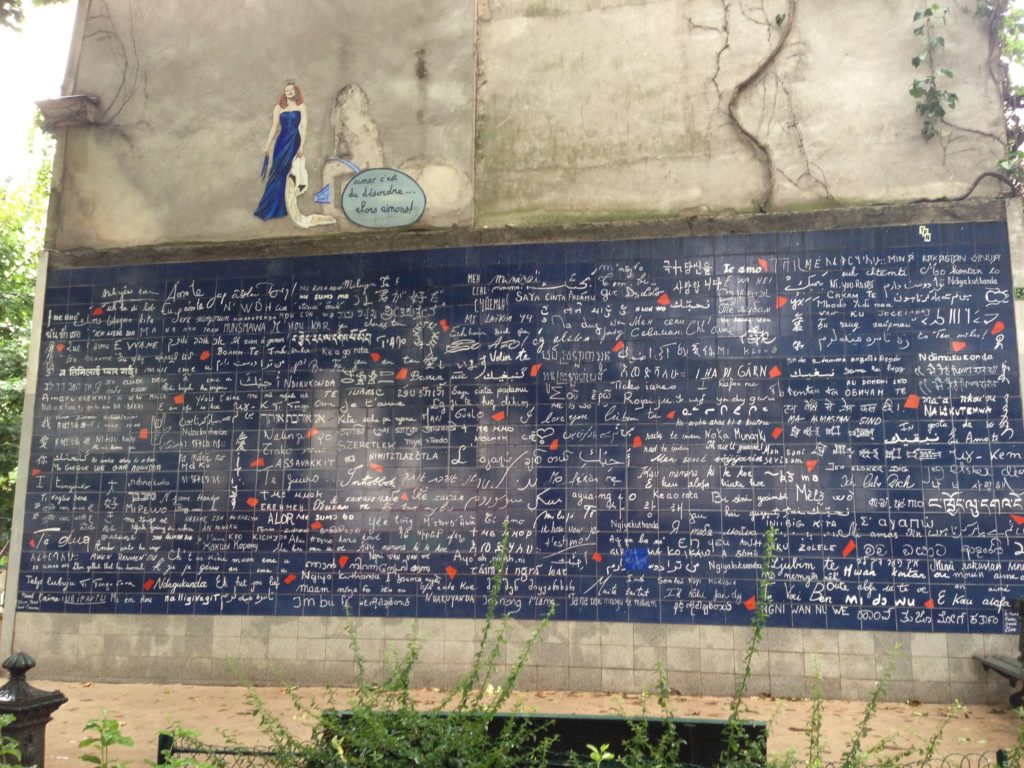
which is quite close to the Abbesses station. It’s the creation of Frédéric Baron and Claire Kito. There are 612 square enameled lava tiles with “I love you” written 311 times in 250 languages on the 40 square meter space and it’s a contemplative curiosity if nothing else.
Unlike the Basilica of Sacré-Coeur on which construction began in 1875 and which wasn’t consecrated until 1919, the original Church of Saint-Pierre dates to the 12th century. However, most of that structure was destroyed during the French Revolution but even the restored building antedates Sacré-Coeur by about a century. I’m glad David highlighted it for us.
The Basilica itself is one of the most recognizable structures in Paris and, coupling its size and location
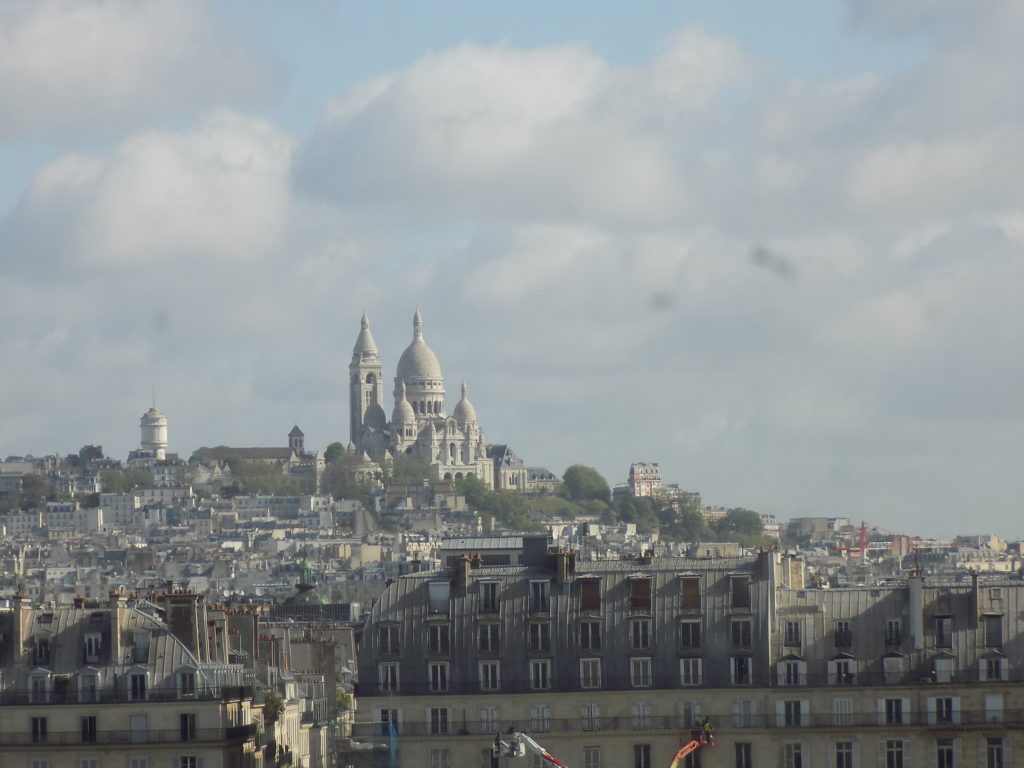
it’s visible from quite some distance. I took this photo through the clock window of the Musée d’Orsay which is on the opposite bank of the Seine nearly four kilometers away.
Having missed an opportunity to ride a bus to Montmartre, Patricia and I decided to use that method to arrive at our next destination, the Trocadero.
Our bus ride took us along the Boulevard du Clichy and through the rather notorious area known as the Pigalle. Although Fodor’s online travel guide has this description,
If you think the Bohemian Belle Epoque Paris that created the Moulin Rouge is a thing of the past, look no further than Pigalle, which lies on the foot on Montmartre at the northern edge of the 9th arrondissement. Near the Place Pigalle, lodged between—and nudging out—the sex shops and dive bars, you’ll find chic cocktail lounges, barista cafés, gastro-bistros, and trend-setting hotels that make a visit to the neighborhood feel like a discovery.
passing through on the bus, Patricia and I discovered very little.
I went to the Trocadero to get at least one iconic tourist photo of the Eiffel Tower (yet one more place we didn’t enter)
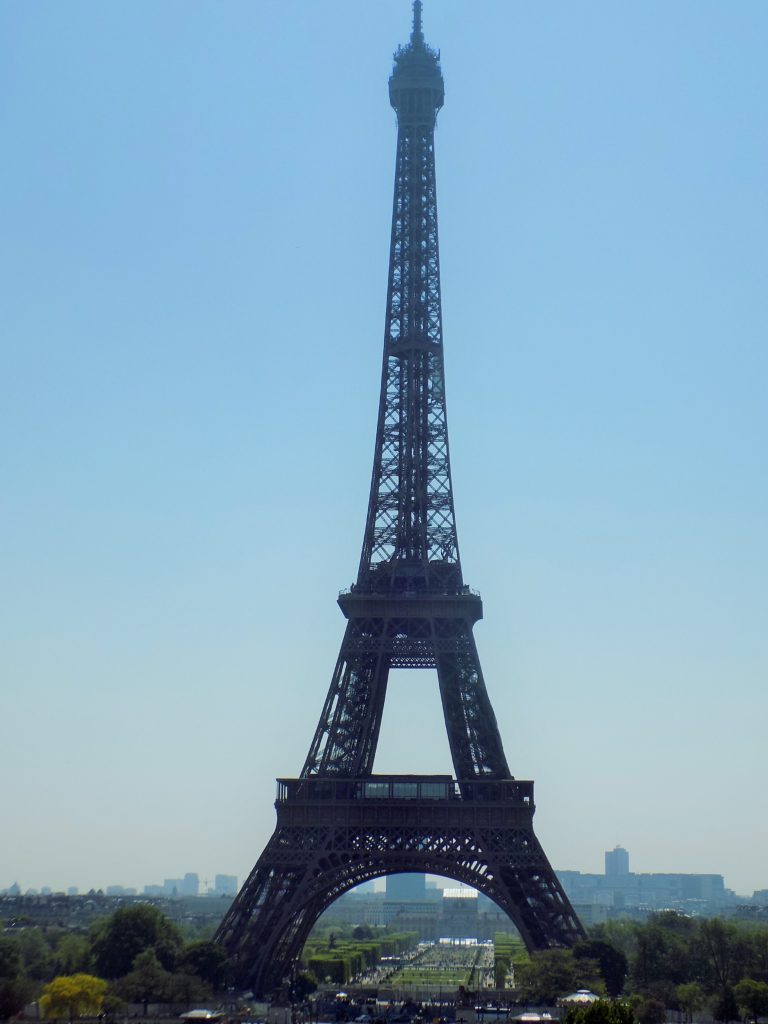
and because it was a short walk from Café New York where Patricia and I planned to meet another couple from the cruise who had also chosen to stay in Paris for a few extra days.
After lunch we walked to le Pont Mirabeau because of that bridge’s connection to our previous week’s boat tour. Beginning to tire, we hopped on an overcrowded bus and rode it without paying the fare to get within walking distance of the Musée de l’Orangerie which features eight of Monet’s large paintings in the Nymphéas (Water Lilies) cycle hung in rooms shaped and lit specifically for their display.
We concluded the day with dinner at Café La Favorite mainly because it offers “service continu” or continuous service and was quite close to the venue holding the concert we planned to attend that evening. (Many Parisian restaurants close for several hours between lunch and dinner.) We followed that by attending a concert featuring Vivaldi’s Four Seasons, Pachelbel’s Canon, and sacred songs Saint-Paul-Saint-Louis Church just a block or two from our flat.
Sunday.
Since we had few plans, we started Sunday morning with a “free guided walking tour” (the guides work for tips only) in the hope that we might glean some new and interesting facts about the city. We saw la plus vieille horloge de Paris (the oldest clock – more or less – in Paris)
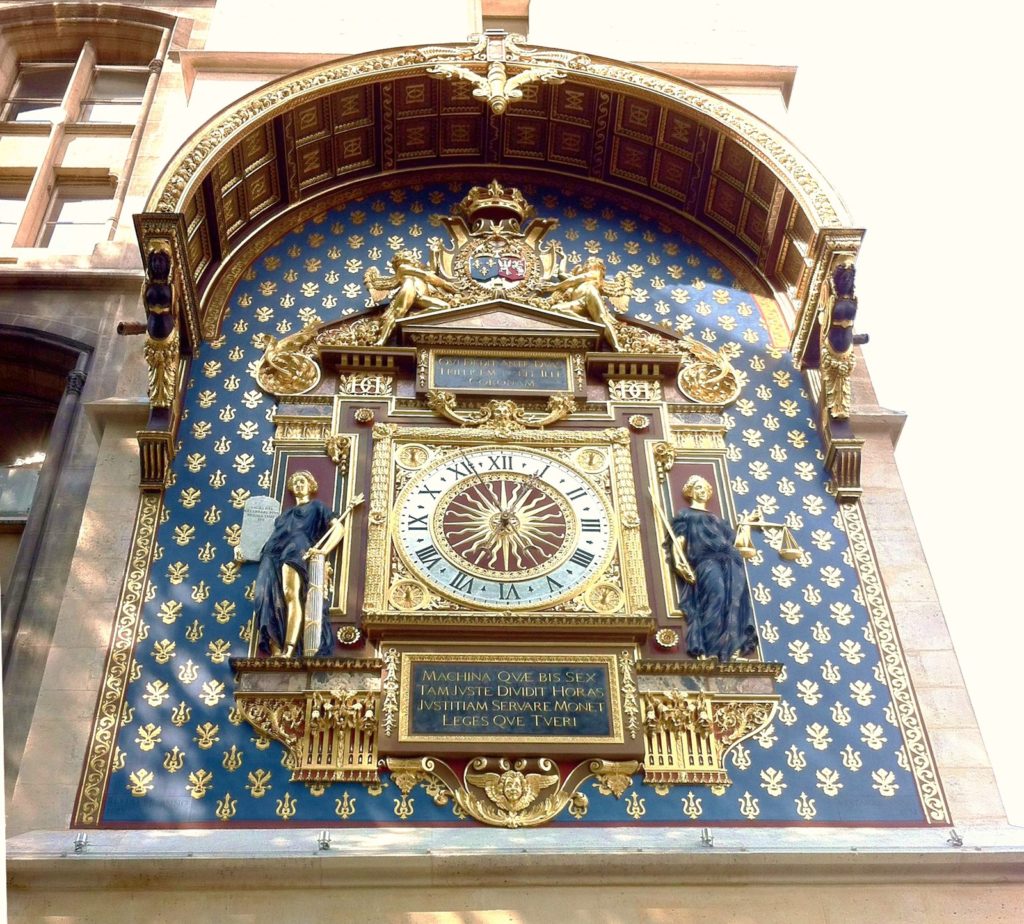
and our guide added a somewhat detailed history of le Louvre which began its life as a fortress. Everything else on the tour we had learned on our first day.
After the tour ended and I snapped my photo of the Arc de Triomphe du Carrousel (You’ll have to read the original post if you want to learn why this was a picture I wanted to take.) we set off for the Musée Rodin (Rodin Museum) in Paris. (There’s actually a second Rodin Museum in Meudon.)
A list and description of just a few of the great sculptor’s most iconic works would require an entry far longer than I intend to write though you can read about them beginning in this post if you’d like. (And yes, there is a brief discussion and photo of The Thinker.) Rodin cast his great breakthrough in Brussels in 1875 while working for Albert-Ernest Carrier-Belleuse.

Called L’Âge d’airain (The Age of Bronze), it was accepted into the Salon of 1877. (The Salon began in 1737 in the Louvre and was the annual exhibition by the Royal Academy of Painting and Sculpture of its members’ works. The Salon had previously rejected Rodin more than once.)
Monday.
Monday, our last full day in Paris, began with the typical petit-déjeuner at the Little Café with an irrepressibly happy server who set the tone for the day. We lingered over breakfast longer than was necessary to merely consume the meal but we had no plan so we lazily allowed the day to spread slowly in front of us. Fortunately, the hospitality of the French café allows diners to sit undisturbed for as long as they please.
We set off westward along rue de Rivoli toward the Saint-Jacques or Saint James Tower. It is from here that French pilgrims, if they so chose began their walk along El Camino de Santiago de Compostela or The Way of Saint James. (In French this would be le Chemin de Saint Jacques de Compostelle. In fact, beginning in the 16th-century, when pilgrims met in Paris to begin their walk along the via Tourensis, the traditional meeting point was the Tour Saint-Jacques.
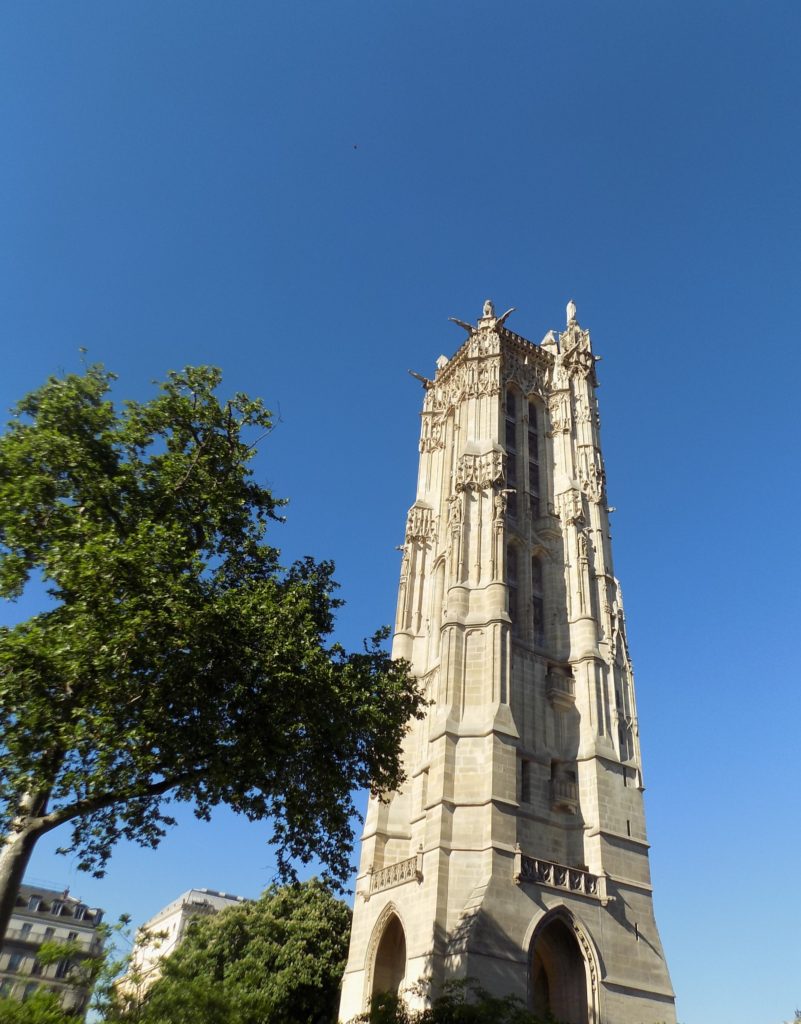
From there, they would begin the journey south and east along the oldest street in Paris – rue Saint-Jacques. If you are capable and inclined to make the full pilgrimage from Paris, you have only 2,000 kilometers remaining.
We actually followed the Chemin for a short distance before setting off up the hill the Parisians call Montagne Sainte-Geneviève – bypassing visiting the church called Saint-Étienne-du-Mont where we would have seen the shrine to Sainte-Geneviève and the tombs of Blaise Pascal and Jean Racine.
Continue up the hill as we did and you reach the Panthéon – a building begun in 1758 as the fulfillment of a promise made by King Louis XV during the War of Austrian Secession. Completed in 1790 it’s an early example of architectural Neoclassicism, with its portico supporting 24 Corinthian columns modeled after the second-century Pantheon in Rome. The Revolutionary government changed its purpose from a church to a mausoleum but it was consecrated under Napoléon Bonaparte in 1806.
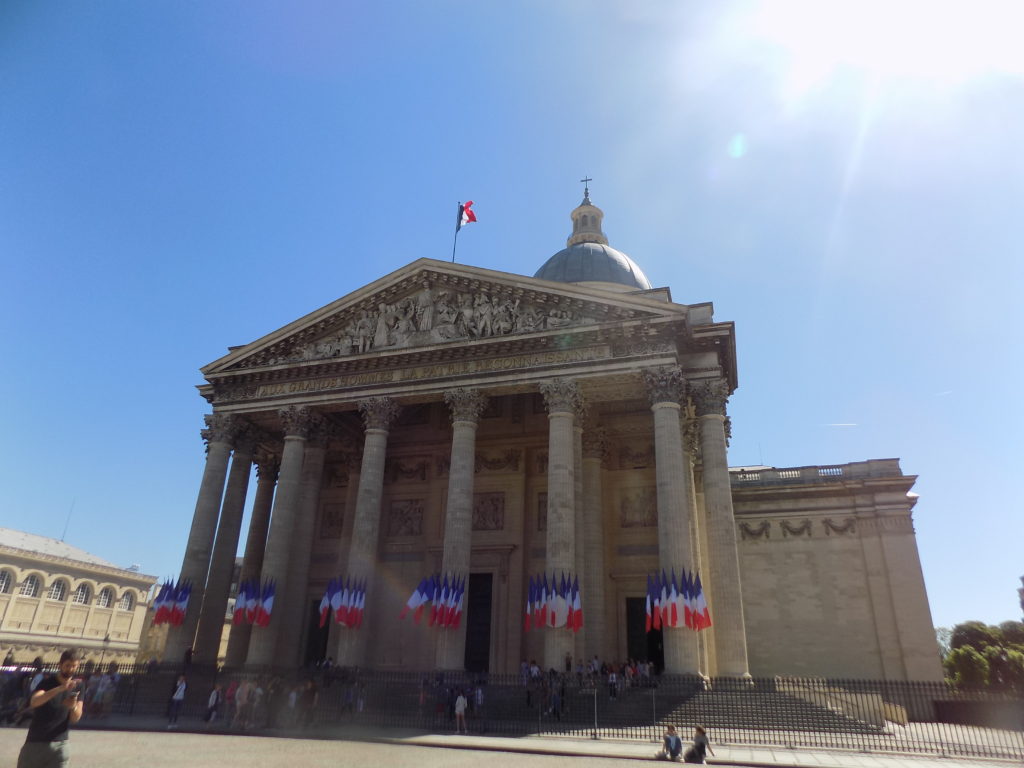
A notable scientific event happened here in 1851 when the physicist Léon Foucault set up his famous experiment in which he installed his specially designed pendulum in the dome of the Panthéon to prove the rotation of the earth. And it is here that you can find the graves of Henri Rousseau, Victor Hugo, Émile Zola, Jean Moulin, and Louis Braille as well as the exhumed and reinterred Alexandre Dumas and Marie Curie.
We finished our day at the hiding in plain sight Jardin Tino-Rossi (Tino Rossi Garden) along the left bank of the Seine that a sign near the entrance describes as a musée de sculpture en plein air (open-air sculpture museum). It was a late afternoon in early May so we didn’t find what parisjetaime describes as as place where in evenings from June through August “hundreds of dancers gather spontaneously at the Jardin Tino Rossi, just below the Institut du Monde Arabe. With salsa, tango, traditional Breton dancing, rock, etc., there’s something for all tastes!” but we did find a place to take a quiet stroll along the Seine punctuated with pauses to consider and admire some of the artwork there.
And with this, I’ll end my still lengthy but highly condensed recap of my time in Paris.
On to the Olympics.